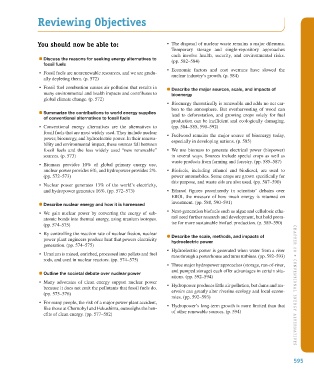Page 596 - Environment: The Science Behind the Stories
P. 596
Reviewing Objectives
You should now be able to: • The disposal of nuclear waste remains a major dilemma.
Temporary storage and single-repository approaches
each involve health, security, and environmental risks.
Discuss the reasons for seeking energy alternatives to (pp. 582–584)
fossil fuels
• Economic factors and cost overruns have slowed the
• Fossil fuels are nonrenewable resources, and we are gradu- nuclear industry’s growth. (p. 584)
ally depleting them. (p. 572)
• Fossil fuel combustion causes air pollution that results in Describe the major sources, scale, and impacts of
many environmental and health impacts and contributes to bioenergy
global climate change. (p. 572)
• Bioenergy theoretically is renewable and adds no net car-
bon to the atmosphere. But overharvesting of wood can
Summarize the contributions to world energy supplies lead to deforestation, and growing crops solely for fuel
of conventional alternatives to fossil fuels
production can be inefficient and ecologically damaging.
• Conventional energy alternatives are the alternatives to (pp. 584–585, 590–592)
fossil fuels that are most widely used. They include nuclear • Fuelwood remains the major source of bioenergy today,
power, bioenergy, and hydroelectric power. In their renewa- especially in developing nations. (p. 585)
bility and environmental impact, these sources fall between
fossil fuels and the less widely used “new renewable” • We use biomass to generate electrical power (biopower)
sources. (p. 573) in several ways. Sources include special crops as well as
waste products from farming and forestry. (pp. 585–587)
• Biomass provides 10% of global primary energy use,
nuclear power provides 6%, and hydropower provides 2%. • Biofuels, including ethanol and biodiesel, are used to
(pp. 572–573) power automobiles. Some crops are grown specifically for
this purpose, and waste oils are also used. (pp. 587–590)
• Nuclear power generates 13% of the world’s electricity,
and hydropower generates 16%. (pp. 572–573) • Ethanol figures prominently in scientists’ debates over
EROI, the measure of how much energy is returned on
Describe nuclear energy and how it is harnessed investment. (pp. 588, 590–591)
• We gain nuclear power by converting the energy of sub- • Next-generation biofuels such as algae and cellulosic etha-
atomic bonds into thermal energy, using uranium isotopes. nol need further research and development, but hold prom-
(pp. 574–575) ise for more sustainable biofuel production. (p. 589–590)
• By controlling the reaction rate of nuclear fission, nuclear Describe the scale, methods, and impacts of
power plant engineers produce heat that powers electricity hydroelectric power
generation. (pp. 574–575)
• Hydroelectric power is generated when water from a river
• Uranium is mined, enriched, processed into pellets and fuel runs through a powerhouse and turns turbines. (pp. 592–593)
rods, and used in nuclear reactors. (pp. 574–575)
• Three major hydropower approaches (storage, run-of-river,
and pumped storage) each offer advantages in certain situ-
Outline the societal debate over nuclear power
ations. (pp. 592–594)
• Many advocates of clean energy support nuclear power
because it does not emit the pollutants that fossil fuels do. • Hydropower produces little air pollution, but dams and res- CHAPTER 20 • CONVENTI ON AL ENERGY ALTERN ATIVES
(pp. 575–576) ervoirs can greatly alter riverine ecology and local econo-
mies. (pp. 592–593)
• For many people, the risk of a major power plant accident,
like those at Chernobyl and Fukushima, outweighs the ben- • Hydropower’s long-term growth is more limited than that
efits of clean energy. (pp. 577–582) of other renewable sources. (p. 594)
595
M20_WITH7428_05_SE_C20.indd 595 13/12/14 1:56 PM

